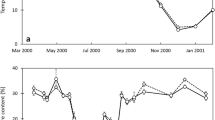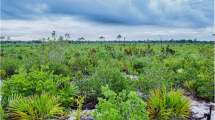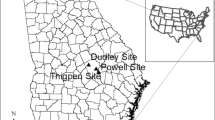Abstract
Restoring longleaf pine (Pinus palustris Mill.) over much of its original range requires artificial regeneration. In central Louisiana, USA, two fertilization levels—No (NF) or Yes (F-36 kg/ha N and 40 kg/ha P) in combination with three vegetation treatments—Check, four prescribed fires (PF), or multi-year vegetation control by herbicidal and mechanical means (IVM) were applied to container-grown longleaf pine plantings in a grass savanna. After 10 years, P concentration in longleaf pine foliage was less on NF plots than F plots, but fertilization did not significantly affect tree stature. Survival was greater on NF plots than F plots, and so, NF plots were more productive (NF—63 m3/ha and F—45 m3/ha). Pine trees on IVM plots (37 dm3/tree) were significantly larger than on Check and PF plots, which averaged 17 dm3/tree. Survival was better on IVM plots (88%) than PF plots (78%), which was better than Checks (58%). Consequently, IVM plots were most productive (99 m3/ha), followed by PF plots (44 m3/ha), and lastly Checks (28 m3/ha). PF plots had greater grass cover (38%) than Check and IVM plots, which averaged 5%, whereas PF and IVM plots had less understory arborescent cover (an average of 25%) than Checks (91%). A wildfire in March 2007 reduced pine survival by 22, 14, and 1 percentage points on IVM, Check, and PF plots, respectively. Seven months later, longleaf pine production had decreased to 92 m3/ha on IVM plots while increasing to 55 m3/ha on PF plots and 30 m3/ha on Checks. Overall, the wildfire rejuvenated the herbaceous plant community. Grass cover on Check and IVM plots averaged 20% while grass cover on PF plots was 36%. Forb cover increased on all treatments from 2% before the wildfire to 13% seven months after the wildfire. Understory arborescent cover decreased on Checks to 62% but increased slightly on PF and IVM plots and averaged 30%.


Similar content being viewed by others
References
Anderson PH, Johnsen KH (2009) Fertilizer responses of volunteer longleaf pine trees within a loblolly pine plantation: separating direct effects from competition effects. Southern research station research paper SRS-48, US Department of Agriculture, Forest Service, Asheville, 6 pp
Baldwin VC Jr, Saucier JR (1983) Aboveground weight and volume of unthinned, planted longleaf pine on West Gulf forest sites. Southern forest experiment station research paper SO-191, US Department of Agriculture, Forest Service, New Orleans, 25 pp
Barnett JP, McGilvray JM (1997) Practical guidelines for producing longleaf pine seedlings in containers. Southern research station general technical report SRS-14, US Department of Agriculture, Forest Service, Asheville, 28 pp
Blevins D, Allen HL, Colbert S, Gardner W (1996) Nutrition management for longleaf pinestraw. North Carolina cooperative extension service woodland owners notes no 30, NC State University, Raleigh, 8 pp
Boyer WD (1987) Volume growth loss: a hidden cost of periodic prescribed burning in longleaf pine? South J Appl For 11(3):154–157
Boyer WD, Miller JH (1994) Effect of burning and brush treatments on nutrient and soil physical properties in young longleaf pine stands. For Ecol Manage 70:311–318
Brockway DG, Outcalt KW (2000) Restoring longleaf pine wiregrass ecosystems: hexazinone application enhances effects of prescribed fire. For Ecol Manage 137:121–138
Brockway DG, Outcalt KW, Boyer WD (2006) Longleaf pine regeneration ecology and methods. In: Jose S, Jokela EJ, Miller DL (eds) The longleaf pine ecosystem ecology, silviculture, and restoration. Springer, New York, pp 95–133
Brockway DG, Outcalt KW, Estes BL, Rummer RB (2009) Vegetation response to midstory mulching and prescribed burning for wildfire hazard reduction and longleaf pine (Pinus palustris Mill.) ecosystem restoration. Forestry 82:299–314
Brose PH, Wade D (2002) Potential fire behavior in pine flatwood forests following three different fuel reduction techniques. For Ecol Manage 163:71–84
Bruce D (1947) Thirty-two years of annual burning in longleaf pine. J For 45(11):809–814
Bruce D (1951) Fire, site, and longleaf height growth. J For 49:25–28
Burton JD (1984) A continuous function approach to measuring response of young pine plantations to rates of application of nitrogen and phosphorus fertilizers. II longleaf pine on Ruston and Lucy soils. Southern forest experiment station establishment report FS-S0-1102-7.10, US Department of Agriculture, Forest Service, Pineville, 12 pp
Byram (1958) Some basic thermal processes controlling the effects of fire on living vegetation. Southeast forest experiment station research note no 114. US Department of Agriculture, Forest Service, Asheville, 2 pp
Campbell JW, Hanula JL, Outcalt KW (2008) Effects of prescribed fire and other plant community restoration treatments on tree mortality, bark beetles, and other saproxylic Coleoptera of longleaf pine, Pinus palustris Mill., on the Coastal Plain of Alabama. For Ecol Manage 254:134–144
Croker TC Jr (1987) Longleaf pine: a history of man and a forest. US Department of Agriculture, Forest Service, South Region, Atlanta, Georgia forestry report R8-FR 7, 37 pp
Deeming JE, Burgan RE, Cohen JD (1977) The national fire-danger rating system—1978. Intermountain forest and range experiment station general technical report INT-39, US Department of Agriculture, Forest Service, Ogden, 63 pp
Derr HJ (1957) Effects of site treatment, fertilization, and brownspot control on planted longleaf pine. J For 55:364–367
Ferguson ER, Biggs CB, Thatcher RC (1960) “Cool” burns and pine mortality. Fire Control Notes 21(1):27–29
Grelen HE, Enghardt HG (1973) Burning and thinning maintain forage in a longleaf pine plantation. J For 71:419–420, 425
Grelen HE, Lohrey RE (1978) Herbage yield related to basal area and rainfall in a thinned longleaf plantation. Southern forest experiment station research note SO-232, US Department of Agriculture, Forest Service, New Orleans, 4 pp
Hanula JL, Meeker JR, Miller DR, Barnard EL (2002) Association of wildfire with tree health and numbers of pine bark beetles, reproduction weevils and their associates in Florida. For Ecol Manage 170:233–247
Hardin ED, White DL (1989) Rare vascular plant taxa associated with wiregrass (Aristida stricta) in the southeastern United States. Natural Areas J 9:234–245
Hayes MJ (2010) What is drought? National Drought Mitigation Center, University of Nebraska, Lincoln. http://www.drought.unl.edu/whatis/indices.htm. Accessed 19 May 2010
Haywood JD (1995) Prescribed burning and hexazinone herbicide as release treatments in a sapling hardwood-loblolly pine stand. New For 10:39–53
Haywood JD (2000) Mulch and hexazinone herbicide shorten the time longleaf pine seedlings are in the grass stage and increase height growth. New For 19:279–290
Haywood JD (2005) Effects of herbaceous and woody plant control on Pinus palustris growth and foliar nutrients through six growing seasons. For Ecol Manage 214:384–397
Haywood JD (2007) Influence of herbicides and felling, fertilization, and prescribed fire on longleaf pine establishment and growth through six growing seasons. New For 33:257–279
Haywood JD (2009a) Eight years of seasonal burning and herbicidal brush control influence sapling longleaf pine growth, understory vegetation, and the outcome of an ensuing wildfire. For Ecol Manage 258:295–305
Haywood JD (2009b) Influence of pine straw harvesting, prescribed fire, and fertilization on a Louisiana longleaf pine site. South J Appl For 33:115–120
Haywood JD, Grelen HE (2000) Twenty years of prescribed burning influence the development of direct-seeded longleaf pine on a wet pine site in Louisiana. South J Appl For 24:86–92
Haywood JD, Tiarks AE (1990) Eleventh-year results of fertilization, herbaceous, and woody plant control in a loblolly pine plantation. South J Appl For 14:173–177
Haywood JD, Harris FL, Grelen HE (2001) Vegetative response to 37 years of seasonal burning on a Louisiana longleaf pine site. South J Appl For 25:122–130
Hiers JK, O’Brien JJ, Will RE, Mitchell RJ (2007) Forest floor depth mediates understory vigor in xeric Pinus palustris ecosystems. Ecol Appl 17:806–814
Hough WA (1969) Caloric value of some forest fuels of the southern United States. Southeast forest experiment station research note SE-120, US Department of Agriculture, Forest Service, Asheville, 6 pp
Jose S, Merritt S, Ramsey CL (2003) Growth, nutrition, photosynthesis and transpiration responses of longleaf pine seedlings to light, water and nitrogen. For Ecol Manage 180:335–344
Kais AG, Cordell CE, Affeltranger CE (1986) Benomyl root treatment controls brown-spot disease on longleaf pine in the southern United States. For Sci 32:506–511
Kerr A Jr, Griffis BJ, Powell JW, Edwards JP, Venson RL, Long JK, Kilpatrick WW (1980) Soil survey of Rapides Parish, Louisiana. US Department of Agriculture, Soil Conservation Service and Forest Service, in cooperation with Louisiana State University, Louisiana agricultural experiment station, Alexandria, 87 pp
Landers JL, Van Lear DH, Boyer WD (1995) Longleaf pine forests of the Southeast: requiem or renaissance? J For 93(11):39–44
Lewis CE (1977) Longleaf pine responds through age 15 to early fertilization. Southeast forest experiment station research note SE-239, US Dept of Agriculture, For Service, Asheville, North Carolina, 7 pp
Loveless RW, Pait JA III, McElwain T (1989) Response of longleaf pine to varying intensity of silvicultural treatments. Proc Bienn South Silvic Res Conf 5:159–164
McNab WH, Avers PE, comps (1994) Ecological subregions of the United States: section descriptions. US Department of Agriculture, Forest Service, Washington Office Admin Pub WO-WSA-5, 267 pp
National Climatic Data Center (2009) US Department of Commerce, NOAA Satellite and Information Service, http://lwf.ncdc.noaa.gov/oa/ncdc.html. Accessed 11 Jan 2010
Nelson LR, Zutter BR, Gjerstad DH (1985) Planted longleaf pine seedlings respond to herbaceous weed control using herbicides. South J Appl For 9:236–240
O’Brien J, Hiers JK, Mordecai K, Gordon D (2007) Physiological effects of organic soil consumption on mature longleaf pine (Pinus palustris). Longleaf alliance report no 10, pp 39–40
Outcalt KW (1993) Southern pines performance on sandhills sites in Georgia and South Carolina. South J Appl For 17:100–102
Outcalt KW, Wade DD (2004) Fuels management reduces tree mortality from wildfires in southeastern United States. South J Appl For 28:28–34
Pessin LJ (1944) Stimulating the early height growth of longleaf pine seedlings. J For 42:95–98
Ramsey CL, Jose S, Brecke BJ, Merritt S (2003) Growth response of longleaf pine (Pinus palustris Mill.) seedlings to fertilization and herbaceous weed control in an old field in southern USA. For Ecol Manage 172:281–289
SAS Institute Inc (1985) SAS user’s guide: statistics, 5th edn. SAS Institute Inc., Cary, 956 pp
Schmidtling RC (1987) Relative performance of longleaf compared to loblolly and slash pines under different levels of intensive culture. Proc Bienn South Silvic Res Conf 4:395–400
Shoulders E (1985) The case for planting longleaf pine. Proc Bienn South Silvic Res Conf 3:255–260
Steel RGD, Torrie JH (1980) Principles and procedures of statistics a biometrical approach, 2nd edn. McGraw-Hill Book Company, New York, 633 pp
Sullivan BT, Fettig CJ, Otrosina WJ, Dalusky MJ, Berisford CW (2003) Association between severity of prescribed burns and subsequent activity of conifer-infesting beetles in stands of longleaf pine. For Ecol Manage 185:327–340
Sword Sayer MA, Haywood JD (2009) Fire and longleaf pine physiology—does timing affect response? Proceedings of the 2009 Society of American Foresters Convention, 11 pp
Sword Sayer MA, Haywood JD, Sung S-JS (2009) Cavity size and copper root pruning affect production and establishment of container-grown longleaf pine seedlings. For Sci 55:377–389
Tiarks AE (1983) Effects of site preparation and fertilization on slash pine growing on a good site. Proc Bienn South Silvic Res Conf 2:34–39
Turner RL, Van Kley JE, Smith LS, Evans RE (1999) Ecological classification system for the national forests and adjacent areas of the West Gulf Coastal Plain. The Nature Conservancy, Nacogdoches, 305 pp
US Fish and Wildlife Service (2009) Longleaf pine range-wide conservation initiative. US Department of the Interior, Fish and Wildlife Service. http://www.fws.gov/southeast/SHC/pdf/LongleafPineLCC.pdf. Accessed 10 Feb 2010
Wahlenberg WG (1946) Longleaf pine its use, ecology, regeneration, protection, growth, and management. Charles Lathrop Pack Forestry Foundation and US Department of Agriculture, Forest Service, Washington, DC, 429 pp
Waldrop TA, White DL, Jones SM (1992) Fire regimes for pine-grassland communities in the southeastern United States. For Ecol Manage 47:195–210
Wiegert RG, Monk CD (1972) Litter production and energy accumulation in three plantations of longleaf pine (Pinus palustris Mill). Ecology 53:949–953
Wolters GL (1982) Longleaf and slash pine decreases herbage production and alters herbage composition. J Range Manage 35:761–763
Author information
Authors and Affiliations
Corresponding author
Rights and permissions
About this article
Cite this article
Haywood, J.D. Influence of herbicides and felling, fertilization, and prescribed fire on longleaf pine growth and understory vegetation through ten growing seasons and the outcome of an ensuing wildfire. New Forests 41, 55–73 (2011). https://doi.org/10.1007/s11056-010-9209-9
Received:
Accepted:
Published:
Issue Date:
DOI: https://doi.org/10.1007/s11056-010-9209-9




